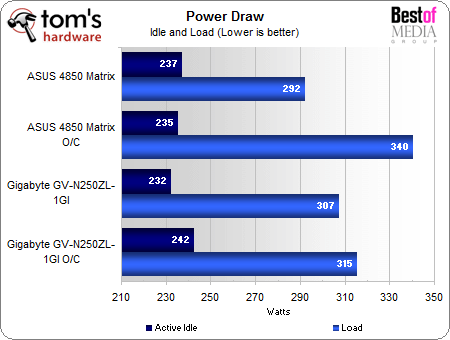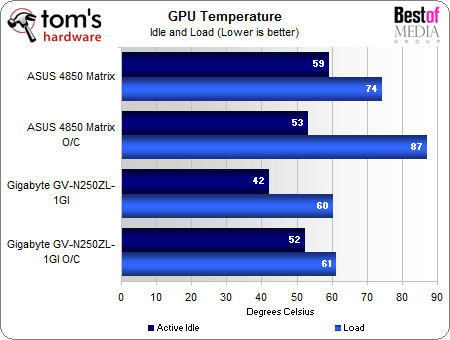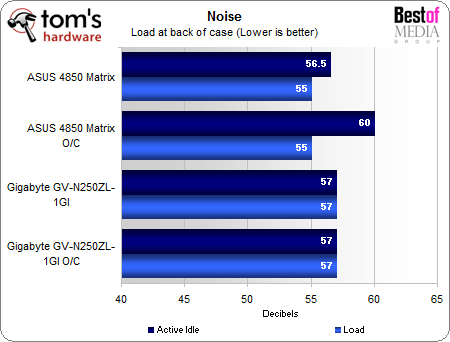Radeon HD 4850 Vs. GeForce GTS 250: Non-Reference Battle
Power, Temperature, And Noise Benchmarks
Of course, there’s more to a graphics card than raw performance. Let’s have a look at other aspects of these products, starting with power draw.
What we’ve done is measure total system power at the wall with a single GeForce 8400 GS installed at idle and we've used the 210 W result as a baseline. We then measured idle power and load power with these cards using only a graphics-intensive load, specifically the Sanctuary demo from Unigine. This engine places extremely taxing demands on the graphics system.
It’s interesting how the Asus 4850 Matrix draws the least power at stock clocks and the most power when overclocked. This is due to the large voltage increase afforded by Asus’ iTracker software when set to higher speeds. Note that the modded Asus card still has a very low power draw at idle, thanks to the 2D setting of the iTracker profile, allowing us to draw even less power with the stock settings when 2D clocks are set low despite the high 3D overclock.
Contrast these results with the Gigabyte GV-N250ZL-1GI, which draws more power than the Asus EAH4850 Matrix at stock speeds, but draws less when both are overclocked. Remember, there is no voltage adjustment on the Gigabyte card, ensuring that even when overclocked there will not be the colossal power increase we see with the Asus product.
With this in mind, let’s have a look at the GPU temperatures:
Here we see results reminiscent of the power draw, but for different reasons. Notice how the Asus Radeon 4850 Matrix is much hotter than the Gigabyte GeForce GTS 250, as the Radeon HD 4850 is known to be a hot-running GPU. Although Asus’ impressive heatpipe cooler keeps it in check, things still get hot when the card is overclocked and voltage is added.
Conversely, we see that the Gigabyte card barely registers a temperature change when overclocked under load compared to the stock clocks. Idle temperature is much higher on the overclocked Gigabyte card.
Get Tom's Hardware's best news and in-depth reviews, straight to your inbox.
Finally, let’s have a look at noise. Unfortunately, our test system is rather loud in this case and these cards are so quiet that it was difficult to get meaningful data. In the future we’re going to use a different noise-testing methodology, but for now let’s consider what we have.
The Asus EAH4850 MT has a passive mode, so it’s completely silent at idle. The 55 decibels you’re seeing there is the ambient noise from the system as we had to test the sound close to the cards to get any reading at all. Under normal operation the card is extremely quiet, but as you can see under the extreme overclock and increased voltage mode, we set the fan speed high to keep the temperatures down.
The Gigabyte GV-N250ZL-1GI, on the other hand, remained acceptably quiet across the board. It did produce a little more noise in 2D windows applications since it doesn't have a passive mode, but it’s still a very quiet card.
Current page: Power, Temperature, And Noise Benchmarks
Prev Page Game Benchmarks: Burnout Paradise: The Ultimate Box Next Page ConclusionDon Woligroski was a former senior hardware editor for Tom's Hardware. He has covered a wide range of PC hardware topics, including CPUs, GPUs, system building, and emerging technologies.
-
tuannguyen rags_20In the second picture of the 4850, the card can be seen bent due to the weight.Reply
Hi rags_20 -
Actually, the appearance of the card in that picture is caused by barrel or pincushion distortion of the lens used to take the photo. The card itself isn't bent.
/ Tuan -
jebusv20 demonhorde665... try not to triple post.Reply
looks bad... and eratic. and makes the forums/coments system
more clutered than need be.
ps. your not running the same bench markes as Toms so your not really comparable.
yes, same game and engine, but for example in crysis, the frame rates are completely different from the start, through to the snowey bit at the end.
pps. are you comparing your card to there card at the same resolution? -
alexcuria Hi,Reply
I've been looking for a comparison like this for several weeks. Thank you although it didn't help me too much in my decision. I also missed some comments regarding the Physix, Cuda, DirectX 10 or 10.1 and Havok discussion.
I would be very happy to read a review for the Gainward HD4850 Golden Sample "Goes Like Hell" with the faster GDDR5 memory. If it then CLEARLY takes the lead over the GTS 250 and gets even closer to the HD4870 then my decision will be easy. Less heat, less consumption and almost same performance than a stock 4870. Enough for me.
btw. Resolutions I'm most interested in: 1440x900 and 1650x1080 for 20" monitor.
Thank you -
spanner_razor Under the test setup section the cpu is listed as core 2 duo q6600, should it not be listed as a quad? Feel free to delete this comment if it is wrong or when you fix the erratum.Reply -
KyleSTL Why a Q6600/750i setup? That is certainly less than ideal. A Q9550/P45 or 920/X58 would have been a better choice in my opinion (and may have exhibited a greater difference between the cards).Reply -
B-Unit zipzoomflyhighand no the Q6600 is classified as a C2D. Its two E6600's crammed on one die.Reply
No, its classified as a C2Q. E6600 is classified as C2D. -
KyleSTL ZZFhigh,Reply
Directly from the article on page 11:
Game Benchmarks: Left 4 Dead
Clearly this is not an ideal setup to eliminate the processor from affecting benchmark results of the two cards. Most games are not multithreaded, so the 2.4Ghz clock of the Q6600 will undoubtedly hold back a lot of games since they will not be able to utilize all 4 cores.
Let’s move on to a game where we can crank up the eye candy, even at 1920x1200. At maximum detail, can we see any advantage to either card?
Nothing to see here, though given the results in our original GeForce GTS 250 review, this is likely a result of our Core 2 Quad processor holding back performance.
To all,
Stop triple posting!
-
weakerthans4 ReplyThe default clock speeds for the Gigabyte GV-N250ZL-1GI are 738 MHz on the GPU, 1,836 MHz on the shaders, and 2,200 MHz on the memory. Once again, these are exactly the same as the reference GeForce GTS 250 speeds.
Later in the article you write,or the sake of argument, let’s say most cards can make it to 800 MHz, which is a 62 MHz overclock. So, for Gigabyte’s claim of a 10% overclocking increase, we’ll say that most GV-N250ZL-1GI cards should be able to get to at least 806.2 MHz on the GPU. Hey, let’s round it up to 807 MHz to keep things clean. Did the GV-N250ZL-1GI beat the spread? It sure did. With absolutely no modifications except to raw clock speeds, our sample GV-N250ZL-1GI made it to 815 MHz rock-solid stable. That’s a 20% increase over an "expected" overclock according to our unscientific calculation.
Your math is wrong. A claim of 20% over clock on the GV-N250ZL-1GI would equal 885.6 MHz. 10% of 738MHz = 73.8 MHz. So a 10% overclock would equal 811.8 MHz. 815 MHz is nowhere near 20%. In fact, according to your numbers, the GV-N250ZL-1GI barely lives up to its 10% minimal capability.


